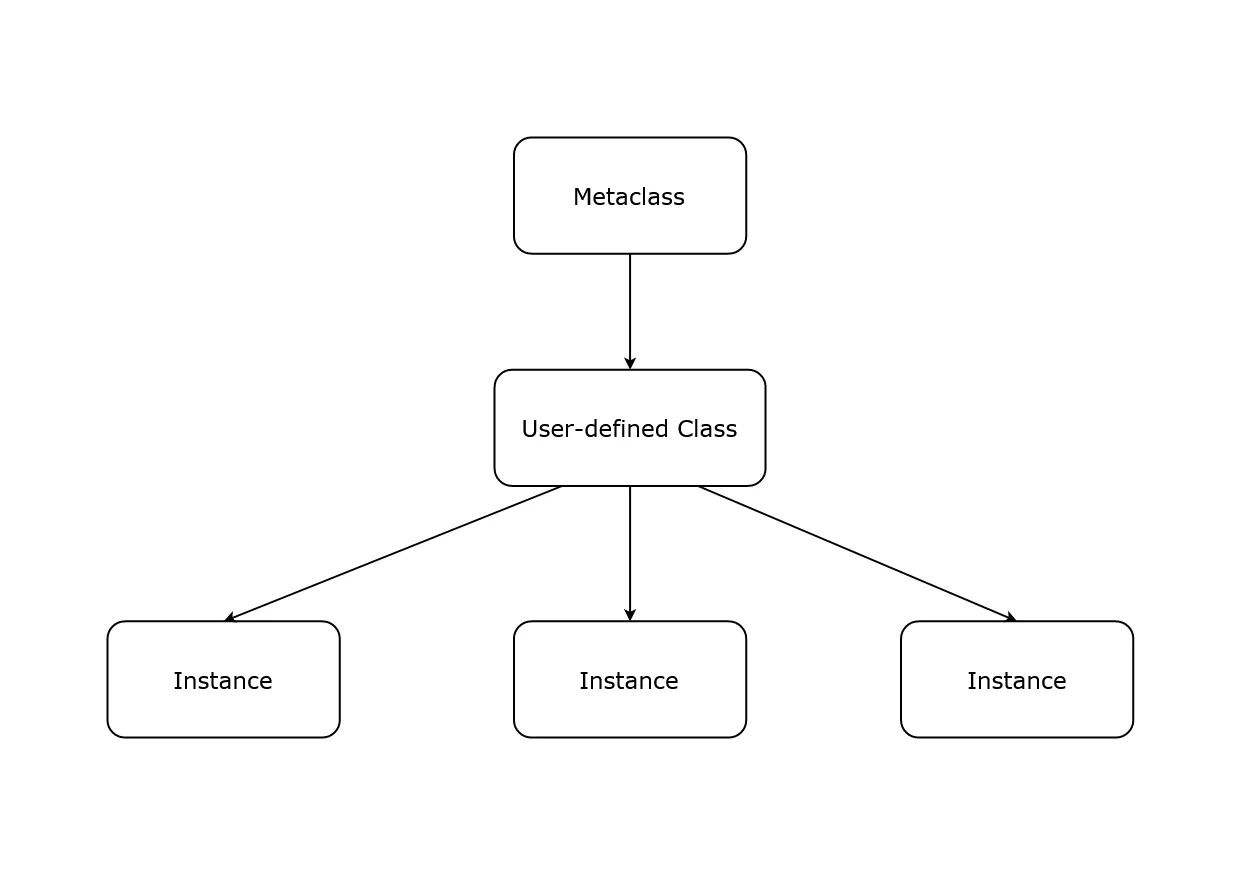What are metaclasses in Python
A beginners guide to metaclasses in Python.
Metaclass is an advanced Python concept and is not used in day-to-day programming tasks. They allow a user to precisely define a class state, change its attributes and control method behavior.
#more
In this article, we will understand how metaclasses can be created and used in Python.
1. Type and OOP¶
Everything is an object in Python, including classes. Hence, if classes are an object, they must be created by another class also called as Metaclass.

So, a metaclass is just another class that creates class objects. Usually, type is the built-in metaclass Python uses for every class. But we can also create our own metaclasses with custom behavior.
2. Understanding the type() function¶
To fully understand Metaclasses, one needs to thoroughly understand type().
In Python, type() is used to identify the data type of a variable. If we have the following code
var = 12
print(type(var))
Console output would be:
<class 'int'>
Indicating var is an instance of the class int.
In the case of a user-defined class, we get the following output.
class Foo:
def bar():
pass
foo_obj = Foo()
print("Type of Foo's instance is:", type(foo_obj))
print("Type of Foo is:", type(Foo))
Type of Foo's instance is: <class '__main__.Foo'>
Type of Foo is: <class 'type'>
Here, we can see foo_obj is correctly identified as an instance of class Foo, but the type of class Foo indicates that it is an instance of class type, establishing the point that classes are indeed created by other classes.
Creating classes dynamically using type()¶
This is one more concept we should know before diving into metaclasses.
This usage of type() is fairly unknown. The type() function can take three arguments and can be used to create classes dynamically:
type(name: str, bases: tuple, attributes: dict)
nameindicates the name of a classbasesis a tuple of classes to be inheritedattributesis a dictionary including all variables and methods to be declared inside the new class
Example:
Dummy = type("Dummy", (), {"var1": "lorem ipsum sit domat"})
dummy = Dummy()
print(dummy.var1)
Output:
lorem ipsum sit domat
3. Creating Metaclass¶
The main purpose of a metaclass is to change the class automatically when it's created.
To use class as a metaclass we pass metaclass=ClassName as a class parameter. The metaclass itself is implemented like a normal class with any behavior we want. Usually the __new__ function is implemented.
The name of the metaclass should ideally make the intent of the class clear:
Example:
class PrintAttributeMeta:
def __new__(cls, class_name, bases, attributes):
print("Attributes received in PrintAttributeMeta:", attributes)
return type(class_name, bases, attributes)
class Dummy(metaclass=PrintAttributeMeta):
class_var1 = "lorem"
class_var2 = 45
Output:
Attributes received in PrintAttributeMeta: {'__module__': '__main__', '__qualname__': 'Dummy', 'class_var1': 'lorem', 'class_var2': 45}
This meta class simply prints all attributes, and then creates and returns a new class by using the type() function.
Note that there’s output without creating an instance of the class because the __new__() method is called when the class is created.
4. Modifying a class state using Metaclass¶
Using Metaclasses, the user can perform multitude of validations and modification such as changing variable names, raising error on receiving an invalid data type, checking inheritance levels, etc.
For this example, we will write a Metaclass that raises a ValueError when a negative value is received in attributes.
class PositiveNumbersMeta:
def __new__(cls, class_name, bases, attributes):
for attr, value in attributes.items():
if isinstance(value, (int, float)) and value < 0:
raise ValueError(f"Negative values are not allowed in {class_name}")
return type(class_name, bases, attributes)
class MyClass(metaclass=PositiveNumbersMeta):
class_var1 = 23
class_var2 = -1
Output:
Traceback (most recent call last):
File "<stdin>", line 1, in <module>
File "<stdin>", line 5, in __new__
ValueError: Negative values are not allowed in MyClass
We could also change attributes:
class PositiveNumbersMeta:
def __new__(cls, class_name, bases, attributes):
for attr, value in attributes.items():
if isinstance(value, (int, float)) and value < 0:
attributes[attr] = -value
return type(class_name, bases, attributes)
class MyClass(metaclass=PositiveNumbersMeta):
class_var1 = 23
class_var2 = -1
a = MyClass()
print(a.class_var2) # 1
5. Use proper OOP principles¶
In the previous example we are calling type directly and aren't overriding or calling the parent's __new__. Let's do that instead:
class PositiveNumbersMeta(type):
def __new__(cls, class_name, bases, attributes):
for attr, value in attributes.items():
if isinstance(value, (int, float)) and value < 0:
attributes[attr] = -value
return super.__new__(class_name, bases, attributes)
Now our metaclass inherits from type, and by calling the super.__new__() we are using the OOP syntax and call the __new__() function of the base class.
6. When to use metaclasses?¶
There are several reasons to do so:
- The intention is clear. When you read PositiveNumbersMeta, you know what's going to follow
- You can use OOP. Metaclass can inherit from metaclass, override parent methods, etc. Metaclasses can even use other metaclasses.
- You can structure your code better. You never use metaclasses for something as trivial as the above example. It's usually for something complicated. Having the ability to make several methods and group them in one class is very useful to make the code easier to read.
- You can hook on
__new__,__init__and__call__. Which will allow you to do different stuff, Even if usually you can do it all in__new__, some people are just more comfortable using__init__.
Resource: Here's a great StackOverflow answer that explains it well.
Note that Metaclasses are usually only used in more complex scenarios, and in 99% of cases you don't have to worry about it. One common use case is when creating an API. A typical example of this is the Django ORM.
FREE VS Code / PyCharm Extensions I Use
✅ Write cleaner code with Sourcery, instant refactoring suggestions: Link*
Python Problem-Solving Bootcamp
🚀 Solve 42 programming puzzles over the course of 21 days: Link*